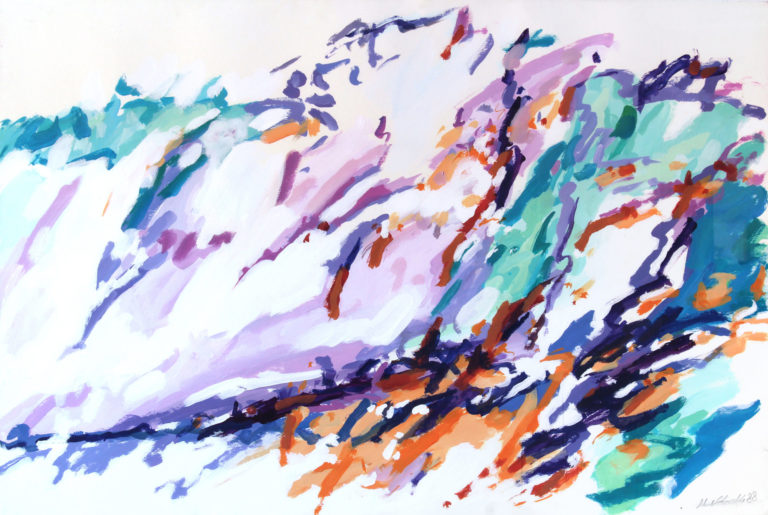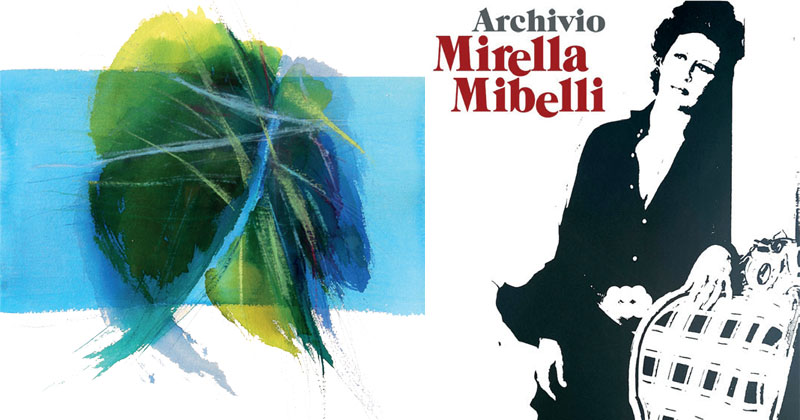Interview with Mirella Mibelli
Today we have the opportunity to share with you this beautiful Interview with Mirella Mibelli, an artist who passed away in 2015.
The interview is from 2004, taken from ‘Tracce nell’acqua’ by Maria Dolores Picciau, current Assessore alla Cultura at the Municipality of Cagliari.

Interview with Mirella Mibelli
M.D.P. Yours is painting imbued with sentiment and poetry, inspired by direct observation of reality
M.M. I have spent a lot of time observing the sea, the rocks, basically the landscape of Sardinia. Observing from the boat or around the countryside always provoked great emotions in me, I always wondered why and came to the conclusion that I was basically trying to explain with flashes of light and vibrant lines the sensations that the world provoked in me.
What grabbed and intrigued me was the fact that what I was observing were signs and colour. During the first years of my career, I worked without knowing what I was doing, I was concerned about the correctness of the technique, the balance of the composition, the juxtaposition of colours, only later did I enter the ‘research channel’ and then I realised that the work comes from your work and I believe that the person who said that the painter always paints the same picture is right.
M.D.P. You started very young. How did you approach art and what were the most important references for you in terms of education and then art?
M.M. Ever since I was a teenager, I used to paint naive landscapes, portraits, still lifes, where the main aim was to achieve some resemblance to the reality I was trying to copy. Possessing no painting technique, the results were often very disappointing, even though I almost never got the proportions, the perspective wrong. I really did not know what art was, its meaning, its purpose.
M.D.P. At one point, you left Sardinia to study outside. Was it a difficult choice for a woman?
M.M. After attending the fifth gymnasium, since neither an art institute nor an art lyceum existed in Sardinia in 1953, my father finally agreed to let me attend an art school in Rome. I then left for the Continent and attended the Zileri Art Institute.
You can imagine what it was like for a fifteen-year-old girl, eager for autonomy, freedom, a bit of a rebel in fact, to be able to choose her own studies and to do so in a city considered to be the heart of history, of culture, of cinema. I was happy and excited, all the more so because the school immediately turned out to be very different from what I had expected.
The institute, which, as I later learned, had been founded by a group of artists, including Toti Scialoja, in opposition to the state art school, where the academic approach was prevalent, was a welcome surprise. It dealt with composition, strictly abstract, on the level of balance, on the right position of colour. It was all new and intriguing to me and I threw myself headlong into the work. The artists of reference were Paul Klee, Cézanne, Kokoschka, Burri, the Impressionists and contemporary art.
M.D.P. The meeting with Kokoschka in Austria. Do you remember it as a defining moment in your career?
M.M. When I returned to Sardinia, full of enthusiasm, I found a situation that had stood still thirty years before, I continued working and after a few years with other artists we founded Gruppo 58. I heard about the ‘school of seeing’ directed by Kokoschka, I was admitted to attend and left for Salzburg. The school was located in the castle overlooking the city, a fantastic place. We pupils worked with professional models for about seven hours a day under the supervision of assistants, there was a break for lunch, then we went back to work. In the middle of the morning the master would arrive, check each student’s work, talk to us, criticise the work done. With me he spoke a strange language that was a mixture of Italian, English, Spanish and French, but we understood each other very well.
M.D.P. What did the Austrian master teach you?
M.M. He was a man, certainly handsome and charming, nice and full of charisma, he taught me the importance of space through colour. We all used watercolours because it was important to use a fast technique with the models changing position after ten minutes of posing. I worked a lot, I made a lot of interesting acquaintances, the school was attended by the children of many European artists, like Darius Milhaud’s son to name but one; Daniel was his name and he was there with his wife and recently born son. There was also the grandson of the greatest dancer of all time, I think his name was Nijinski, others whose names I no longer remember.
M.D.P. Had anything changed in Sardinia in the meantime? Ouando you returned to the island and what did you find different?
M.M. Nothing, I took part in some group exhibitions with Gruppo 58, then I got married and had two children that I took care of exclusively until 1968.
I resumed teaching and painting trying to make up for lost time without stopping until some time ago, when the disease, multiple sclerosis, which struck me in 1990, prevented me from using my right hand seven years later. So I can no longer paint.
M.D.P. You have long ventured into watercolour, a genre that more than others has given you the opportunity to express those lyrical and emotional nuances intrinsic to your poetics
M.M. I believe that watercolour is the technique that is most congenial to me, as I am a sensitive and impatient person. This technique does not allow for second thoughts and corrections, so the result is always something fresh, immediate, quick. Every time the outcome is an unexpected surprise and I like challenges.
M.D.P. What other techniques do you favour?
M.M. In my almost forty-year career, I have delved into many other techniques in which one needs to reflect more, such as oil, but above all, I have been passionate about engraving techniques: woodcut, intaglio (aquatint, etching), stone lithography, silkscreen printing and other experimental techniques. It was very interesting to tackle this work, where my figuration was mediated by the materials (zinc, copper, wood, stone) on which one always has to work. The first print always offered incredible results.
M.D.P. In Quartu, you intervened with a large work on a town wall. How did you create this impressive work?
M.M. I prepared a sketch that envisaged the use of materials that would resist the weather over time, in my case terracotta and rusty iron, playing with a few colour variations. I entrusted everything to a company which, under the artistic direction of two people I trusted, made it.
M.D.P. Do you therefore believe in the social function of art?
M.M. I have always been absolutely sure of that, art like culture helps its users to live better.
M.D.P. How do you find the artistic environment in Sardinia?
M.M. If I exclude a few good artists, who doggedly go on without giving up in their work, I find the environment uninspiring and discouraging.
M.D.P. What about the art market?
M.M. It is practically non-existent, institutions buy little or nothing, exhibitions are now only visited by insiders, who do not normally buy.
I have sold enough in the past, even now that I can no longer paint.
M.D.P. Do you have any projects in the pipeline?
M.M. Because of my illness, I don’t paint any more, so I find it difficult to plan, to make projects. I can only invent something very different from painting, maybe one day not too far away I will find a possibility, in the meantime, I try…
Interview with Mirella Mibelli by Maria Dolores Picciau
Here is the link to the website of the artist Mirella Mibelli – Painter (1937 – 2015)
Here is the link to the website of Maria Dolores Picciau https://mariadolorespicciau.it
You have just read the Interview with Mirella Mibelli by Maria Dolores Picciau, if you liked the article we also recommend the Interview with Antonio Mallus | ConnectivArt
ConnectivArt.



